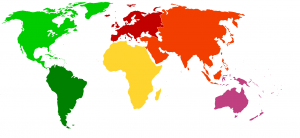https://www.youtube.com/shorts/xOA7dKSThWY Hey! Welcome to my fourth entry at MC Voices, today I will be showing…

Welcome back Raptors! New year, new me, new you and all that jazz right? Haha. It’s February now, 2019 is chugging along and classes have been going on for a few weeks. Hopefully, everything is going well with you. Are you taking more interesting classes this semester? Is your schedule more calm or hectic? At some point, I think most people have taken a sociology class or two and now I can finally add myself to that group. I took Sociology last semester and while we discussed many things. I think one of our final topics “Race” is one that resonates with everybody. We were asked to look at race and its evolution through the lens of the American Census.

The very origins of the American Census reflect a racially organized mindset which favors “white” over other categories and is a result of colonization. In 1790, the first year of available data for the American Census there were just three categories: Free white males and females, All other free persons, and Slaves (Piccorossi, 2015). This shows that in its genesis, the American culture valued white skin over all others, even the indigenous peoples of the nation. The notion that the white man conquered the barbaric brown Indians colored most interactions. Those people who were considered “free”, but were not white, were literally classified under the umbrella term “other.” The final category was the working class people of the time period, the slaves. These two groups, all other freed persons and slaves, were associated with being less than white and often grouped together. In the way the census presented at the time, free white males and free white females were listed together and all other freed persons and slaves were listed together.
About 110 years later, in 1900 the American Census was vastly different. At this point in time, the census groups were: White, Black (negro or of negro descent), Indian, Chinese, and Japanese (Piccorossi, 2015). The updated census, while more inclusive than the previous installment, still in essence reflected a lack of understanding both of race and how people identify themselves. The broad categorization of Indian reflected the resistance to knowledge India the sub-continent and its people and the native American people. The categorization of Black with the parenthetical inclusion of “Negro Descent” marking those people with mixed ancestry to choose between one part of themselves and the rest. There is also the appearance of the Chinese and Japanese categories; however, what were people not from these countries to identify as? There was no option for people who couldn’t place themselves in one of the categories listed. The categories that were provided also still contained an inherent sense of “otherness.” The broad categorization of “white” and all the subdivisions and fine-print inclusions in other racial categories reinforced this subtle separation of people.
The appearance and inclusion of previously marginalized peoples was a vast improvement on prior versions; however, it still left many people unable to self-identify with any one group. The most recent Census of 2010 is the most inclusive iteration of the American Census yet. While still having the classification of white and reinforcing “white-first” culture, the census provided the most options yet for individuals to identify themselves with. There were 7 broad groups with 18 subdivisions spread out across them (Piccorossi, 2015). The lack of subdivisions within the white category and the lack of options for mixed-race individuals still shows a mindset in which white-skin is the desired trait. Whereby, everyone who doesn’t have white skin is somehow different and that white-skin is the standard. The American Census is ever-changing, allowing people the opportunity to bring their group to the forefront and choose an identity that means something to the individual. It should be looked at as more of an ancestral history of an individual as opposed to a socially constructed racial perspective and that change is currently actively taking place. Sometime soon, we may see a Census in which ancestry is the focus of classification as opposed to race.
However, don’t take my opinion as your own; do your own research. Join one of the many diverse clubs here at Montgomery College or maybe sign up for a Sociology class at some point. Knowledge is power. Get more of it.




Om, while I agree perhaps in a generalized way with some of what you said, I don’t think the original census was to celebrate ‘whiteness’ over those of color or different ethnicity. I found the link provided very informative. Our founding fathers (this great country is nothing short of a miracle; they deserve some credit) were British and yes, white. However, the first census in 1790 listed heads of household and how many boys/men were in the house. Women were rather an aside, but this was common for a long time. When my grandparents immigrated in 1920, usually women were not listed as they came into Ellis Island, so it is more difficult to trace women ancestors than male. It seems these days people want to make everything about race or gender, but they also need to realize what happened in the context of its time. Can you imagine asking a female secretary now to go make coffee or fetch dry cleaning for her boss? I do agree that instead of checkboxes, people should be able to describe their ethnicity. For example, I am of Lebanese heritage (which makes me Asian by the way as far as continent), but I am to check white on the census box. Plus, there are so many mixed race and ethnic couples now that their kids may prefer one over the other on a form but it isn’t totally representative. I just don’t think it possible to be a checkbox. Let us not forget as well, that many other cultures suffered from forms of slavery and oppression (peasants were slaves in Britain and Irish slaves under King James). In India, there was (is?) a caste system until 1950 (pretty recent!) not related to the issues of the US. These things do make me scratch my head and wonder why. As humans, we have lots of work to do.
https://labor.ny.gov/nys-data-center/pdf/History-of-Race-Ethnicity-Ancestry-Citizenship-in-the-Decennial-Census.pdf